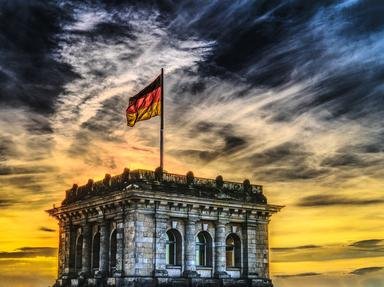Quiz Answer Key and Fun Facts
1. With 340 km of dunes and white sand seashores (reminiscent of the Outer Banks of North Carolina), Mecklenburg-West Pomerania is a mecca for Germany's sunbathers in the summer months. Where in Germany is the state of Mecklenburg-West Pomerania located?
2. This city, capital of Mecklenburg-West Pomerania in medieval times, has the largest market square in Germany (at 10,000 square meters), in which you can find its famous water pump built between 1580 and 1602 in the Dutch Renaissance style.
3. Surrounded by seven lakes, this city is the current capital of Mecklenburg-West Pomerania and was the seat of the ducal court of Mecklenburg from 1358 until the end of World War I.
4. This largest city in Mecklenburg-West Pomerania, located on the Warnow River, was the main seaport of East Germany and suffered from Neo-Nazi riots shortly after Reunification (most likely due to extremely high unemployment). Its Gothic buildings and seaside location now attract over four million visitors each year.
5. From Kap (Cape) Arkona, the northernmost point of this largest island of Germany, you can see the Danish island of Moen.
6. This city on the southern Saaler Bodden seafront lies between two large nature preserves: the Rostocker Heide and Fischland-Darss-Zingst peninsula. It is known as "the City of Amber" ("die Bernsteinstadt").
7. This city, the "Gateway to Rügen", was founded in 1220 and was considered one of the most beautiful of the Hanseatic League cities, earning it the additional nickname, "Pearl of the Hanse." Its Altstadt was made a UNESCO World Heritage Site in June 2002.
8. Lying on the mainland between Germany's two largest islands, this city began as a settlement of pilgrims to the monastery of Eldena (begun in 1199), the foundations of which can still be seen in a small park near the city.
9. While vacationing on the fine, white sand beaches of this upscale resort island, you can stop by the infamous city of Peenemünde, Werner von Braun's rocket base and test firing range, where the V1, V2, and V3 "vengeance weapons" were created.
10. Which cities in Mecklenburg-West Pomerania are currently Hanseatic League (or Hanse) cities?
Source: Author
clg18057
This quiz was reviewed by FunTrivia editor
minch before going online.
Any errors found in FunTrivia content are routinely corrected through our feedback system.
